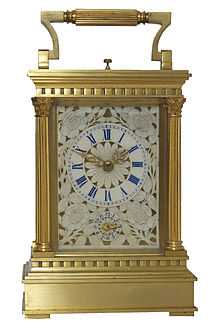Carriage clock

A carriage clock is a small, spring-driven clock, designed for travelling, developed in the early 19th century in France, where they were also known as "Officers' Clocks". The first carriage clock was invented by Abraham-Louis Breguet for the Emperor Napoleon in 1812. The case, usually plain or gilt-brass, is rectangular with a carrying handle and often set with glass or more rarely enamel or porcelain panels. A feature of carriage clocks is the platform escapement, sometimes visible through a glazed aperture on the top of the case. Carriage clocks use a balance and balance spring for timekeeping and replaced the larger pendulum bracket clock. The factory of Armand Couaillet, in Saint-Nicolas d'Aliermont (France) made thousands of carriage clocks between 1880 and 1920.
Sources
- Charles ALLIX and Peter BONNERT, Carriage Clocks. Their history and development,Antique Collector's club, 1974
- Cournarie Emmanuelle, La mécanique du geste, trois siècles d'histoire horlogère à Saint-Nicolas d'Aliermont, Édition PTC-Les Falaises, 2011 (French)
- Lolita Delesque and Marianne Lombardi,Armand Couaillet, horloger et inventeur de génie, Musée de l'horlogerie, juin 2013, 44p (French)
External links
| Wikimedia Commons has media related to Carriage clocks. |